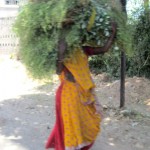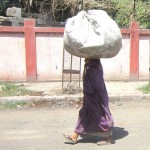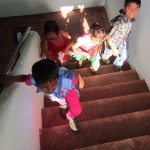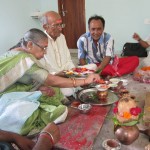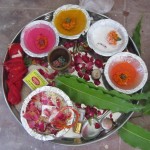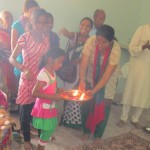Robin Cappuccino is currently visiting all of the Child Haven homes and programs overseas. He has been kind enough to share a glimpse of his journey with us.
Kem cho from Child Haven’s Home for 49 formerly destitute children in Gandhinagar, India. Camels pulling carts lope along beside us and we pass women carrying huge loads of fodder for livestock, and firewood on their heads on our drive to the nearly completed buildings of our Children’s Home. Having had to move from rented facility to rented facility for many years, designing, and building our very own Home on a large rural property is a huge step forward. Bonniema and I are here with Child Haven All-India Board Member, Dr. Suhas Mapuskar, for a puja, or blessing of the new buildings. The doctor will also inspect the new bio-gas and water stabilization system which he has designed. This system will transform the Home’s human wastes into cooking gas, providing a third of our cooking needs, and pathogen-free water for the planned garden.
We arrive for the puja with a bevy of kids, staff, and some of our local board members and friends. The kids have been here several times during construction, but the space is now freshly painted, cleaned, and ready for some thorough exploration. Thanks to a large and generous donation from long-time Child Haven supporters, the Kamra family, the Home is located in two buildings with space for a library, computer room, office, infirmary, kindergarten, dining hall and boys and girls dormitories. As the other kids race from room to room with the staff, 8-year-old Mangu tries the hallway out for dancing, twirling around in the abundant space. Mangu’s father is a rag-picker, and her mother ran away. Being unable to care for her alone he brought her to the Home. Manju leads a rush up the steps to inspect the view from the roof followed by Vinay. Vinay’s father died of tuberculosis, and his mother after first trying to make ends meet living with his grandmother, eventually brought him to Child Haven. Close behind comes Hemangani, whose mother also disappeared and after her school-teacher reported she was being abused was also brought to the Home.
The puja is led by a local Hindu priest with the help of 4 cheerful assistants. A Muslim ceremony will also be held. A blessing is offered in the kitchen and at the entrance to the Dining Hall replete with coconuts garlanded with marigolds, incense, and thrown offerings of rose petals, dhal and rice.
The main ceremony is a 2 hour affair held in what will be the office. Two priests sit on either side of Dr. Chitania and her husband, also Dr. Chitania, local Board Members who represent the Home in the ceremony. As the main priest recites the blessings, the Chitanias are directed in sprinkling rose petals and drops of water on statues of gods and goddesses. They also sprinkle coloured powder from little bowls using marigold blossoms as powder puffs. Rice, seeds and ghee are offered and a multitude of other tasks at the appropriate moments in the ceremony. We are gathered around, sitting cross-legged on small mats. I make a mental note that actually practicing Yoga in addition to thinking it would be a good idea, might come in handy the next time I’m called upon to sit cross-legged for several hours. The chanting of prayers is accompanied by two priests, one playing a rousing rhythm on a large drum with small sticks tied to two of his fingers for added emphasis. The other priest accompanies with an equally lively and surprisingly musical sound made by playing a metal plate with two spoons. The puja is a cheerful affair, much like a wedding with lots of smiling and laughter. While obviously a very prescribed ritual it retains a rather casual air as priests take brief cell-phone calls as needed. Part-way thru, dried cow-dung is brought out, a small part of which is placed in a bowl of water, and the rest placed on decorated bricks and lit with the help of poured ghee. I have to admit that any religious ceremony celebrating cow-dung is my kind of ceremony. “Manure is the farmer’s friend” I remember my father extolling many times when we were kids as we spread it in the garden or used it fresh with a little hay to chink the cracks in our ancient log barn. Of course cows are considered sacred here, and their dung used in many ways. Into the fire, at the appropriate moment in the blessing, is thrown rice, dhal, flower petals, mustard seeds and other propitious items. An alter is slowly being assembled with freshly cleaned and blessed statues of gods and goddesses, all manner of fruit, flowers, sacred symbols and the ends of a thread that encircles the room. One of the goddesses I don’t recognize I later learn is Bahuchara Mata, riding on a rooster. She is considered the patron of the transgender community, and a temple dedicated to her is located in the same district as the Home.
The puja approaches its climax with all the elders together placing a coconut in the fire, which by now has been replenished with kindling. The coconut’s pure water, nutritious fruit and hard shell represent the divine I am told. It also represents selfless service as every part of the tree is used in multiple ways. With drum, plate and chanting climbing to an ever heightening crescendo of spirited rhythm, everyone claps their hands in time, and joins in the chant. Some of the children are brought forward to hold and wave around a plate on which incense is burning as the final blessing. The room is now becoming well smoked by the smoldering fire and incense. Perhaps it is the smoke, but as I ponder the stories of these children, and the expressions of love this building and their on-going support represent, my eyes fill with tears.
Until next time,
Robin Cappuccino for CHI
Stay tuned for another ‘glimpse of the journey’ as Robin continues his travels through the CHI homes in India, Nepal, Bangladesh, and Tibet.


